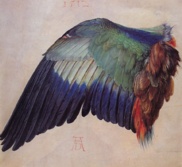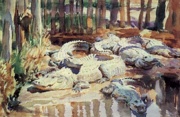
 nature -
The material world and
its phenomena, laws, beauties, etc., especially
those parts remaining in a primitive,
untouched state, unchanged by humans.
nature -
The material world and
its phenomena, laws, beauties, etc., especially
those parts remaining in a primitive,
untouched state, unchanged by humans.
Definitions of art invariably exclude untouched nature, and yet it has been among the most important subjects for artists. Nature has been the principal subject of artists depicting landscapes, seascapes, and animalia, along with much still life; and it is the primary medium as well as subject of those making earth art. Although nature has been important to artists of all periods and movements, it has been especially important to those involved in Romanticism and Naturalism.
Nature was banished from the work of painters producing the geometric images of De Stijl. Piet Mondrian (Dutch, 1872-1944), the group's leading figure, said he would not permit anything green into his studio!
Examples:

Albrecht Dürer (German, 1471-1528),
A Young Hare, 1502, 25 x 23 cm, watercolor
and body color on paper, Graphische Sammlung, Albertina,
Vienna. See Northern Renaissance.

Albrecht Dürer, The
Large Turf, 1503, watercolor
and gouache on
paper, 41 x 32 cm, Graphische Sammlung
Albertina, Vienna.

Albrecht Dürer, Wing of a Roller, 1512, watercolor
and gouache on
vellum, 20 x 20 cm, Graphische
Sammlung, Vienna. Also see feather.
![]()
A Painter ot the Kano School, (Japanese,
active 1596-1614), Falcon on Oak Tree Watching Monkeys,
six-panel folding screen; ink and light color on paper;
no signature; interpolated jar-shaped kuninobu seal
of Kano Eitoku (1543-90), Worcester Art Museum, MA. See Edo
period and landscape.

Jacob van Ruisdael (Dutch, 1628-1682), Dune Landscape with Oak Tree, 1650-55,
black chalk, brush and gray wash and gouache, framing lines in pen and brown ink, 8 1/4 x 7 1/2 inches
(21.0 x 19.1 cm), Metropolitan Museum of Art, NY. See landscape.
Maria Sibylla Merian, (German, 1647-1717), Plate 1 from Dissertation in Insect Generations and Metamorphosis in Surinam, second edition, 1719, hand-colored engraving on paper, 12 3/4 x 9 3/4 inches, National Museum of Women in the Arts, Washington, DC.

Jean-Honoré Fragonard (French, 1732-1806),
A Gathering at Woods' Edge, c. 1760-1780,
red chalk, 14 3/4
x 19 3/8 inches (37.5 x 49.2 cm), Metropolitan Museum of Art,
NY.

Nagasawa Rosetsu (Japanese, 1754-99), Bamboo, 1790s, six-panel folding screen; ink on paper; no signature; seals:
(upper) Nagasawa, (lower) Gyo, Worcester Art Museum, MA. See bamboo,
Edo period, and landscape.

John James Audubon (American, 1785-1851),
Douglass' Squirrel, a study for pl. 48
of Viviparous Quadripeds of North America by John James
Audubon and Rev. John Bachman (New York: John James Audubon,
published 1845-1848), c. 1843, watercolor, ink,
graphite, and glaze
on wove paper, 12 1/4 x
9 1/2 inches (310 x 242 mm), Fine Arts Museums of San Francisco,
CA.

Asher B. Durand (American, 1796-1886), Kindred Spirits, 1849, oil on canvas, 44 x 36 inches, New York Public Library. Durand represented the naturalistic strain of America's Hudson River School. Kindred Spirits is a portrait in nature of the painter Thomas Cole with his friend, the poet William Cullen Bryant.

William Henry Jackson (American, 1843-1942),
Old Faithful, Wyoming, 1870, albumen
print, 20 3/16 x 16 3/4 inches (51.4 x 42.5 cm), J. Paul
Getty Museum, Malibu, CA.

John Singer Sargent (American, born in Italy,
1856-1925), Muddy Alligators, 1917, watercolor over graphite
on off-white wove paper,
Worcester Art Museum, MA.
Georgia O'Keeffe (American, 1887-1986), Pink Shell with Seaweed, c. 1937, 22 x 28 inches, pastel on paper, San Diego Museum of Art, CA. See volute.

Maurits Cornelis Escher, Ant, 1943, lithograph, National Gallery of Art,
Washington, DC. See optical illusion.

Zhang Yuan (Chinese), Autumn Flowers, 1948, ink and color on paper, Phoenix Art Museum, AZ. See botanical and Republican period.
Maurits Cornelis Escher, Puddle, 1952, woodcut in three colors, 24 x 31.9 cm (9 1/2 x 12 1/2 inches).
Maurits Cornelis Escher, Three Worlds, 1955, lithograph, 36.2 x 24.7 cm (14 1/4 x 9 3/4 inches).

Walton Ford (American, 1960-), Falling Bough, 2002, watercolor, gouache, ink and pencil on paper, 60 3/4 x 119 1/2 inches, private collection, TN.
Also see suiseki.
https://inform.quest/_art